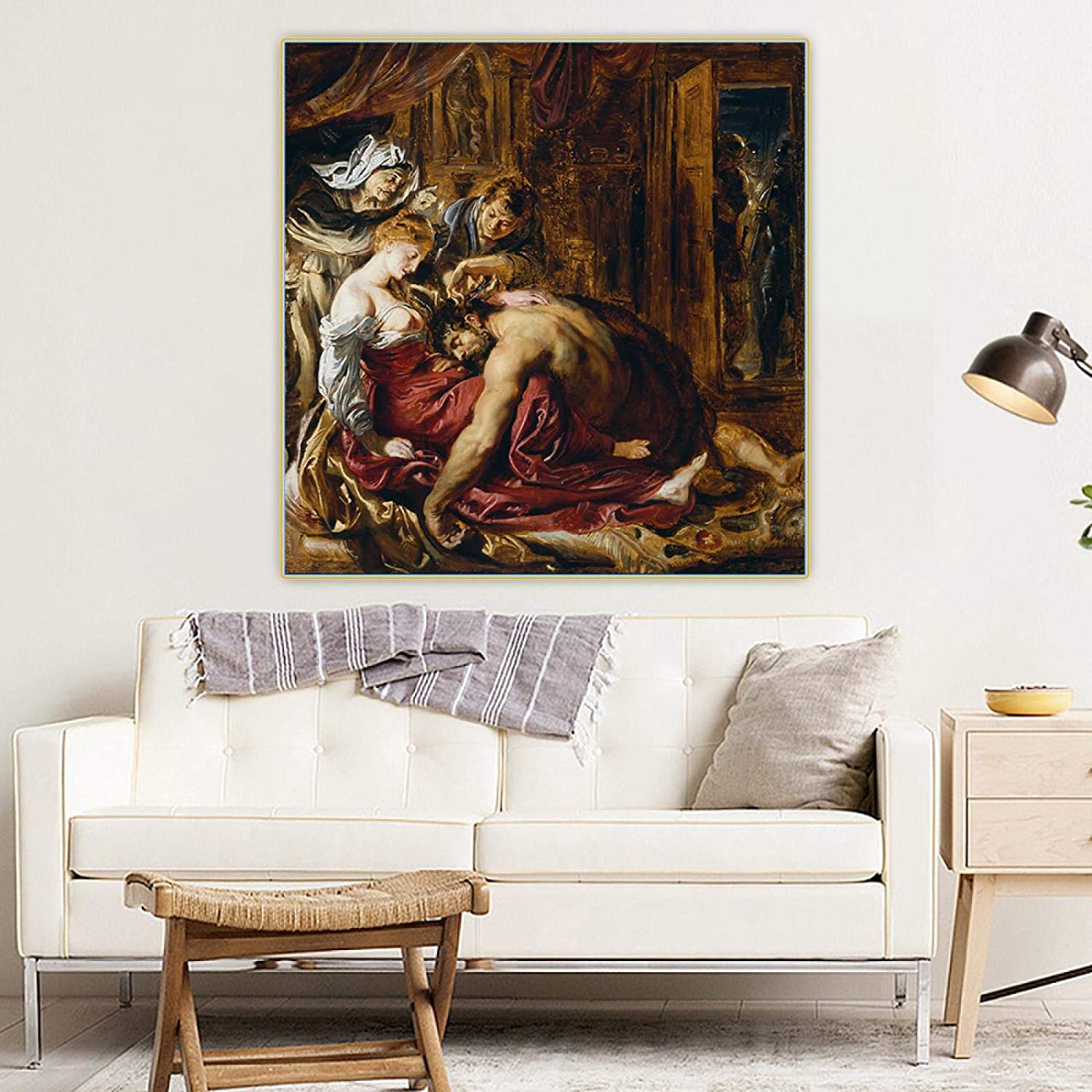Description
Purchased by the National Gallery, London in 1980 for over £2.5 million, Samson and Delilah, which portrays the Biblical characters of the same name as the temptress betrays the hero and cuts off his hair, the source of his powerful strength, it is probably Rubens' most controversial work of art.
Art historian Richard Fremantle criticized the work as too "vulgar" and "crude" for an artist of Rubens's caliber, while believers including English art critic Brian Sewell have affirmed its originality. However, the National Gallery has maintained its position over the years that Samson and Delilah is indeed authentic, apparently with the endorsement of various Rubens experts.
samson and delilah by Peter Paul Rubens portrays a tragedy of love and betrayal. Delilah, Samson's lover, has been bribed to discover the secret of Samson's supernatural strength. Rubens shows the moment when Delilah tells an accomplice to cut his hair, leaving him powerless. Outside, the soldiers wait to capture him.
But maybe Dalila will pay for her betrayal. The old woman's profile behind her is a striking but faded likeness of herself, perhaps suggesting that she will one day lose the beauty that was Samson's downfall.
During a visit to Italy, Rubens had seen Caravaggio's experiments in the use of highly contrasting light and shadow and deep, rich colours. Upon his return, he used these new techniques to paint samson and delilah , commissioned by his friend and patron, Nicolaas II Rockox, Mayor of Antwerp, for his private collection.
The Biblical Story
According to the Old Testament of the Bible (Judges 16), Samson, son of Manoah, was chosen by God to help the Israelites defeat their enemies, the Philistines. In exchange for taking a vow not to shave or cut their hair (the Nazarite vow), Samson was given supernatural physical strength, which he used to perform a variety of heroic feats. Unfortunately, he then fell in love with the temptress Delilah, in the Valley of Sorek. When the Philistines found out about this, they bribed Delilah with 1,100 shekels of silver to discover the secret of Samson's strength. Eventually, he discovers that his strength will wear off if his hair is cut, so one night while Samson is sleeping, he calls for a servant to shave his hair. whereupon the Philistines rush in and overpower him. Later, Samson, whose hair has now grown back, takes revenge by knocking down the pillars of Dagon's Philistine temple, crushing his captors and himself.
The legend has been the subject of numerous religious paintings created during the era of Baroque art, such as "Samson and Delilah" (1629-30, Gemaldegalerie, Berlin) by Rembrandt (1606-69); and "Samson and Delilah" (1654, Musee des Beaux-Arts de Strasbourg) by Guercino (1591-1666).
In this masterpiece of biblical art, Rubens shows a sleeping Samson lying in the arms of Delilah, the woman he loves, while a servant cuts his hair to exhaust his strength. In the background, the Philistine soldiers are waiting to attack as soon as their target has been weakened. Rubens uses symbols to highlight Delilah's deception and Samson's vulnerability. The Philistine barber, for example, who is cutting Samson's hair has his hands crossed, symbolizing deception. And in a niche in the wall behind him is a statue of Venus, the Goddess of love, and her son, Cupid. This alludes to the fact that love is the cause of Samson's downfall. The old woman standing behind Delilah holding a candle to help the barber in his work is not mentioned in the Bible,
On the surface, the scene may appear peaceful, but underneath it contains great tension. Will Delilah's deception work? Or will our Jewish hero wake up and slaughter his rogue raiders? Notice the gentle placement of his hand on her back; it may seem like a gesture of love, but it is only done to calm Samson down and prevent him from waking up and killing her for betraying him.
Rubens' masterful use of chiaroscuro to do justice to Samson's magnificent physique (inspired by Greek sculpture and Michelangelo's Genesis fresco), probably derives from the works of Caravaggio (1573-1610). In fact, the painting was previously attributed to the Dutch artist Gerrit van Honthorst (1592-1656), a painter who worked in Rome in the shadow of Caravaggio, at the beginning of the 17th century. Italian influence is also evident in Rubens' use of color, which owes much to Venetian painting found during the 17th century. The sensuality of the scene is greatly enhanced by the rich colors and textures that are visible throughout the room. In particular, Delilah's luscious red gown, saffron satin bedspread, patterned rugs and hanging purple drapes, as well as dim lighting (itself almost certainly Adam Elsheimer influence) all add to the the feeling and atmosphere of pleasure.

